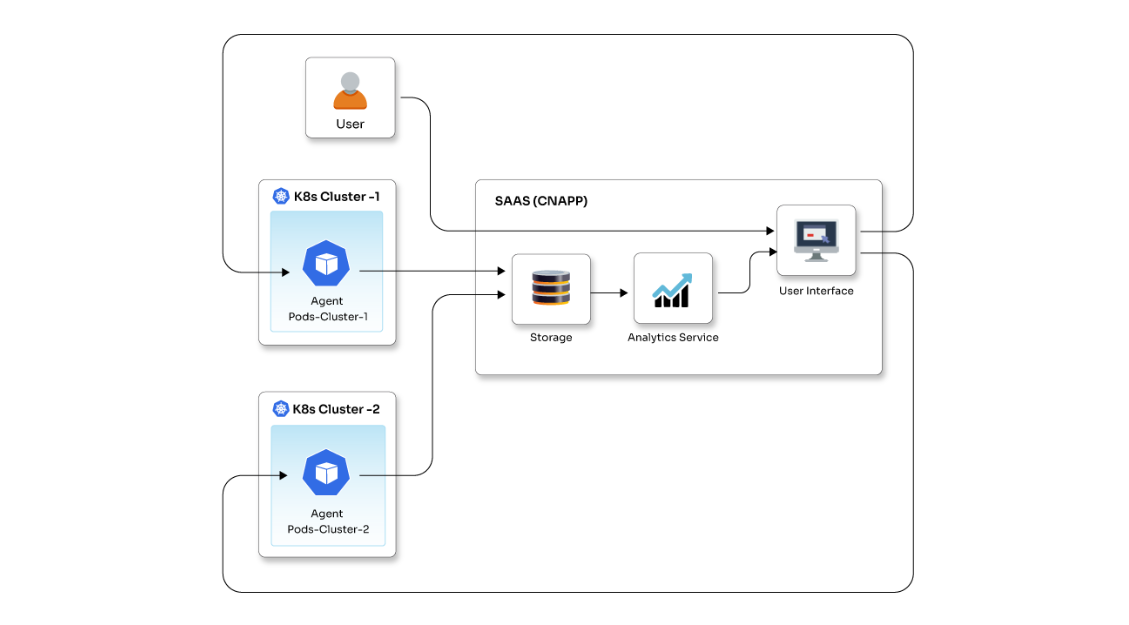How does AI-powered security improve Kubernetes threat detection?

Posted By
Ajinkya Nerkar

Kubernetes is the backbone of modern cloud-native applications, but its dynamic nature makes it a prime target for cyber threats. Attackers exploit misconfigurations, privilege escalations, and network vulnerabilities to infiltrate clusters. Traditional security measures generate excessive alerts, making it hard to identify real threats. This is where AIOps (Artificial Intelligence for IT Operations) comes into play—using AI to detect, analyze, and respond to real-time anomalies.
This blog will explore a real-world scenario where AIOps helps detect and mitigate a Kubernetes security breach.
Scenario: Unusual network activity in a Kubernetes cluster
Imagine a company, FinTechCorp, running microservices in a Kubernetes cluster for its financial application. The cluster hosts services for user authentication, payment processing, and transaction logs.
One day, the security team noticed high outbound traffic from a container running an authentication service. The container is suddenly communicating with an unknown external IP. This unusual activity could indicate a compromised container, an insider attack, or data exfiltration.
How AIOps Detects the Threat
Instead of relying solely on static security rules, FinTechCorp integrates AI-driven anomaly detection using Falco (an open-source Kubernetes threat detection engine) and Machine Learning-based log analysis.
Step 1: Detect Suspicious Network Activity with Falco
Falco monitors system calls in real-time and triggers alerts when unusual network connections occur.
Install Falco in Kubernetes
kubectl apply -f https://raw.githubusercontent.com/falcosecurity/falco/master/integrations/k8s-setup.yaml
Create a Custom Falco Rule for Suspicious Outbound Traffic
- rule: Detect Unexpected Network Connection
desc: Detects outbound connections from a pod to unknown IPs
condition: evt.type = connect and container.id != host and fd.sip != "10.0.0.0/8"
output: "Suspicious outbound connection detected from pod=%container.name to IP=%fd.sip"
priority: CRITICAL
This rule detects any pod connecting to an external IP outside the organization’s private network (10.0.0.0/8).
Falco Triggering an Alert
Falco detects that a container named auth-service is making an outbound connection to 192.168.50.200, which is an unknown external IP.
08:22:14.543 Critical: Suspicious outbound connection detected from pod=auth-service to IP=192.168.50.200
This is a red flag that the authentication service might be compromised.
Step 2: AI-Based Log Analysis to Confirm Suspicious Behavior
AIOps can enhance security by analyzing Kubernetes logs to identify attack patterns.
Collect Kubernetes Logs
kubectl logs -l app=auth-service > auth_logs.txt
Use Machine Learning to Detect Anomalous Login Attempts
We use an Isolation Forest algorithm to analyze logs and identify abnormal login patterns:
from sklearn.ensemble import IsolationForest
import pandas as pd
# Simulated log data with timestamps and login IPs
data = pd.DataFrame({
'timestamp': ['2025-02-12 08:00', '2025-02-12 08:05', '2025-02-12 08:10'],
'login_ip': ['10.0.0.5', '10.0.0.7', '192.168.50.200'] # Unknown external IP
})
# Convert IPs to numerical values for ML analysis
data['ip_numeric'] = data['login_ip'].apply(lambda x: sum(int(octet) << 8*i for i, octet in enumerate(reversed(x.split('.')))))
# Train Isolation Forest for anomaly detection
model = IsolationForest(contamination=0.1)
model.fit(data[['ip_numeric']])
# Predict anomalies
data['anomaly'] = model.predict(data[['ip_numeric']])
# Print suspicious logins
print(data[data['anomaly'] == -1])
Output:
timestamp login_ip anomaly
2 2025-02-12 08:10 192.168.50.200 -1
The AI model confirms that a login attempt from 192.168.50.200 is anomalous, strengthening the case for a security breach.
Step 3: Automated Response – Isolating the Compromised Pod
Now that we’ve confirmed suspicious activity, AIOps can automate containment.
Quarantine the Compromised Pod
kubectl cordon auth-node kubectl drain auth-node --ignore-daemonsets --delete-local-data
This prevents new workloads from running on the affected node.
Delete the Malicious Pod
kubectl delete pod auth-service-1234
This removes the compromised container while maintaining availability through Kubernetes' auto-scaling.
Block Malicious IP at the Kubernetes Network Level
Using Calico Network Policies, we block traffic from the identified malicious IP:
apiVersion: projectcalico.org/v3
kind: GlobalNetworkPolicy
metadata:
name: block-malicious-ip
spec:
selector: all()
order: 100
types:
- Ingress
- Egress
egress:
- action: Deny
destination:
nets:
- 192.168.50.200/32
Apply the policy:
kubectl apply -f block-malicious-ip.yaml
Now, any outgoing traffic to 192.168.50.200 is blocked, preventing further exploitation.
Conclusion
In this real-world scenario, AIOps helped detect, analyze, and respond to a Kubernetes security breach in an automated and intelligent manner:
- Falco detected unusual outbound network activity.
- Machine Learning confirmed anomalous login behavior.
- Automated response isolated the compromised pod and blocked the attacker's IP.
By leveraging AIOps-driven security, FinTechCorp reduced the incident response time from hours to minutes, preventing potential data loss and service disruptions. AIOps isn't just a buzzword—it’s a necessity for securing modern cloud environments. Are you ready to integrate AI-driven security and threat detection into your Kubernetes clusters? Contact our security experts today.
Related Blogs




















